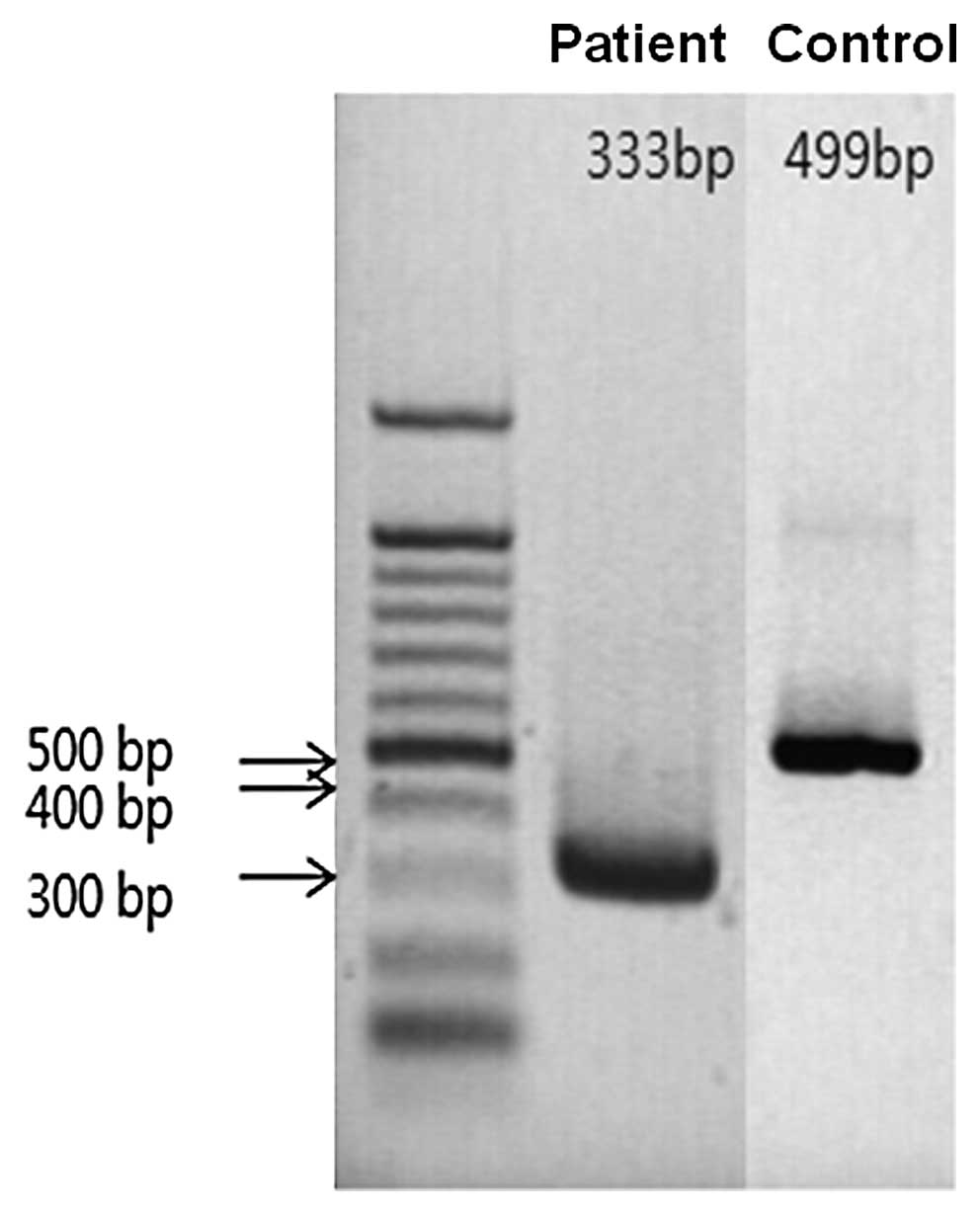A novel mutation of exon 7 in growth hormone receptor mRNA in a patient with growth hormone insensitivity syndrome and neurofibromatosis type I
- Authors:
- Ju-Hyung Kang
- Ok-Soon Kim
- Ja-Hyun Kim
- Seong-Kyu Lee
- Youn-Jong Park
- Haing-Woon Baik
-
View Affiliations
Affiliations: Department of Pediatrics, Eulji University, Daejeon 301-832, Republic of Korea, Department of Biochemistry and Molecular Biology, School of Medicine, Eulji University, Daejeon 301-832, Republic of Korea
- Published online on: June 28, 2012 https://doi.org/10.3892/ijmm.2012.1048
-
Pages:
713-717
Metrics:
Total
Views: 0 (Spandidos Publications: | PMC Statistics:
)
Metrics:
Total PDF Downloads: 0 (Spandidos Publications: | PMC Statistics:
)
This article is mentioned in:
Abstract
Growth hormone insensitivity syndrome (GHIS), a genetic disease characterized by growth retardation combined with high serum concentration of growth hormone (GH) and low insulin-like growth factor 1 (IGF-1) levels, can be caused by mutations in the GH receptor (GHR) gene. We investigated the molecular defects in the GHR gene in a patient with neurofibromatosis type 1 (NF-1). The patient, a 2-year-old boy with NF-1, was assessed on his short stature by auxological, biochemical and molecular studies. Height of the patient and his family members were measured and compared to normal control. Serum concentrations of GH, IGF-1 and IGF-binding protein 3 (IGFBP3) in the patient were measured during a GH stimulation test. We examined the GHR gene in the patient and his parents. Genomic DNA and mRNA of the GHR gene were extracted from peripheral lymphocytes. All the exons and the flanking regions of the GHR gene were amplified by PCR, and directly sequenced. The patient's height was 75 cm (-2.89 SDS) with gradually reducing growth velocity, while the heights of the other family members were within the normal range. The GH stimulation test revealed that serum GH concentrations in the patient were much higher than those in the control group, and serum IGF-1 and IGFBP3 levels were extremely low. There was no germline mutation in the exons or the flanking regions of the patient's GHR gene. Interestingly, a deletion of 166 bases of exon 7 in the GHR mRNA was found, and it was suggested that the novel mutation resulted in premature termination (M207 fs. X8). This mutation decreases GH binding affinity to the GHR, and, thus, would be responsible for growth retardation.
View References
|
1.
|
Neurofibromatosis Conference
statementNational Institutes of Health Consensus Development
ConferenceArch Neurol455755781988
|
|
2.
|
D CarmiM ShohatA MetzkerZ DickermanGrowth,
puberty, and endocrine functions in patients with sporadic or
familial neurofibromatosis type 1: a longitudinal
studyPediatrics10312571262199910.1542/peds.103.6.125710353939
|
|
3.
|
EM KofoedV HwaB LittleGrowth hormone
insensitivity associated with a STAT5b mutationN Engl J
Med34911391147200310.1056/NEJMoa02292613679528
|
|
4.
|
V HwaB LittleP AdiyamanSevere growth
hormone insensitivity resulting from total absence of signal
transducer and activator of transcription 5bJ Clin Endocrinol
Metab9042604266200510.1210/jc.2005-051515827093
|
|
5.
|
Z LaronA PertzelanS MannheimerGenetic
pituitary dwarfism with high serum concentration of growth hormone
- a new inborn error of metabolism?Isr J Med
Sci215215519665916640
|
|
6.
|
Z LaronLaron syndrome (primary growth
resistance or insensitivity): the personal experience 1958–2003J
Clin Endocrinol Metab8910311044200415001582
|
|
7.
|
F VidalE FarssacC AltisentL PuigD
GallardoRapid hemophilia A molecular diagnosis by a simple DNA
sequencing procedure: identification of 14 novel mutationsThromb
Haemost85580583200111341489
|
|
8.
|
PD GluckmanAJ GunnA WrayCongenital
idiopathic growth hormone deficiency is associated with prenatal
and early postnatal growth failureJ
Pediatr121920923199210.1016/S0022-3476(05)80342-71447657
|
|
9.
|
KA WoodC Cabacho-HubnerMO SavageAJ
ClarkIntrauterine growth retardation and postnatal growth failure
associated with deletion of insulin-like growth factor I geneN Eng
J Med33513631367199610.1056/NEJM1996103133518058857020
|
|
10.
|
MH CnossenEN StamLC CooimanEndocrinologic
disorders and optic pathway gliomas in children with
neurofibromatosis type
1Pediatrics100667670199710.1542/peds.100.4.6679310522
|
|
11.
|
J SzudeckP BirchJM FriedmanGrowth in North
American white children with neurofibromatosis 1 (NF1)J Med
Genet37933938200010.1136/jmg.37.12.933
|
|
12.
|
M ClementiS MilaniI MammiNeurofibromatosis
type 1 growth chartsAm J Med
Genet87317323199910.1002/(SICI)1096-8628(19991203)87:4%3C317::AID-AJMG7%3E3.0.CO;2-X10588837
|
|
13.
|
MA BergJ ArgenteS ChernausekDiverse growth
hormone receptor gene mutations in Laron syndromeAm J Hum
Genet52998100519938488849
|
|
14.
|
A EdensF TalamantesAlternative processing
of growth hormone receptor transcriptsEndocr
Rev1955958219989793757
|
|
15.
|
AL RosenbloomaJ Guevara-AguirrebLessons
from the genetics of Laron syndromeTrends Endocrinol
Metab9276283199810.1016/S1043-2760(98)00070-8
|
|
16.
|
PE ClaytonJS FreethMR NormanCongenital
growth hormone insensitivity syndromes and their relevance to
idiopathic short statureClin Endocrinol
(Oxf)50275283199910435051
|
|
17.
|
A DavidLA MetherellAJ ClarkC
Camacho-HübnerMO SavageDiagnostic and therapeutic advances in
growth hormone insensitivityEndocrinol Metab Clin North
Am34581595200510.1016/j.ecl.2005.04.00916085161
|
|
18.
|
LA MetherellSA AkkerPB MunroePseudoexon
activation as a novel mechanism for disease resulting in atypical
growth-hormone insensitivityAm J Hum
Genet69641646200110.1086/32326611468686
|
|
19.
|
M MaamraA MilwardHZ EsfahaniA 36 residues
insertion in the dimerization domain of the growth hormone receptor
results in defective trafficking rather than impaired signalingJ
Endocrinol188251261200610.1677/joe.1.0625216461551
|
|
20.
|
A DavidC Camacho-HübnerA BhangooAn
intronic growth hormone receptor mutation causing activation of a
pseudoexon is associated with a broad spectrum of growth hormone
insensitivity phenotypesJ Clin Endocrinol
Metab92655659200710.1210/jc.2006-1527
|















